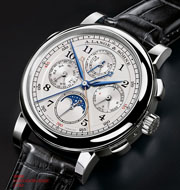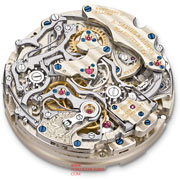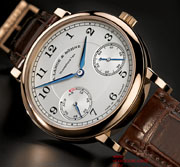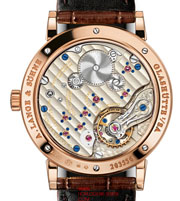

A. Lange & Söhne
Nouveautés 2013 des montres A. Lange & Söhne
1815 Rattrapante Quantième Perpétuel
 L’activation des chronométrages simples ou de temps intermédiaires s’effectue de manière classique et précise via deux roues à colonnes. À l’aide de l’aiguille de chronographe et de la rattrapante qui se chevauchent au centre, de nombreux temps intermédiaires peuvent être chronométrés au sein d’une minute.
L’activation des chronométrages simples ou de temps intermédiaires s’effectue de manière classique et précise via deux roues à colonnes. À l’aide de l’aiguille de chronographe et de la rattrapante qui se chevauchent au centre, de nombreux temps intermédiaires peuvent être chronométrés au sein d’une minute.
À 12 heures se trouvent le compteur des minutes et l’indicateur de la réserve de marche. L’aiguille plus longue en acier bleui renseigne sur le nombre de minutes chronométrées. Quant à l’aiguille dorée, plus courte, dans le cercle intérieur, elle signale qu’il est bientôt temps de redonner de l’énergie au mouvement au moyen de la couronne.
Des 631 composants au total que contient le calibre de manufacture L101.1 nouvellement développé par Lange, plus de 100 font partie du mécanisme du quantième perpétuel.
Ce mécanisme ne tient pas seulement compte des mois de différentes longueurs au cours d’une année calendaire, mais aussi de toutes les années bissextiles jusqu’en 2100. Selon le calendrier grégorien, cette dernière n’est pas une année bissextile, c’est pourquoi le calendrier devra exceptionnellement être avancé à la main en pressant une touche. Il en ira de même lors de toutes les années séculaires suivantes, donc par la suite, en 2200.
Les indicateurs calendaires, allant de pair, se trouvent à 9 et 3 heures. Le cadran auxiliaire de gauche indique la date et le jour de la semaine et celui de droite le mois et l’année bissextile. Sous la petite seconde, à 6 heures, le disque lunaire en or massif, redessiné, reproduit si précisément la révolution synodique du satellite de la Terre que l’affichage devra être corrigé d’un jour dans 122 ans seulement.
L’imposant boîtier en platine ou en or rose, d’un diamètre de 41,9 millimètres, parfait l’esthétique exceptionnelle de ce chef-d’oeuvre horloger.
 Its push piece at the 10 o’clock position implies that there is more than meets the eye. The mechanism behind it is visible through the sapphire-crystal caseback and ranks among the most fascinating ones in a movement. Stopping elapsed or lap times is handled precisely in the classic manner with two column wheels.
Its push piece at the 10 o’clock position implies that there is more than meets the eye. The mechanism behind it is visible through the sapphire-crystal caseback and ranks among the most fascinating ones in a movement. Stopping elapsed or lap times is handled precisely in the classic manner with two column wheels.
The central, superposed chronograph hand and rattrapante hand make it possible to measure any number of lap times within the course of a minute. The minute-counter and power-reserve displays are located at 12 o’clock. The longer blued-steel hand indicates the count of stopped seconds. Conversely, the shorter golden hand in the inner circle tells the owner of the watch when the time has come to replenish the energy of the mainspring via the winding crown.
Of the 631 individual parts of the newly developed manufacture calibre L101.1, more than 200 components are part of the perpetual calendar mechanism. It not only knows the durations of all months in the course of a calendar year but also indicates all leap years until the year 2100. That year, according to the Gregorian calendar, is not a leap year, which is why the date must be manually advanced by one day, with pushbutton convenience.
The same applies to all other secular years, the next one being 2200. The paired calendar indications are positioned at 9 and 3 o’clock.
The subsidiary dial on the left indicates the date and the day of the week, the one on the right the month and the leap year. The newly designed solid-gold lunar disc beneath the subsidiary seconds dial at 6 o’clock emulates the synodic lunation so precisely that it only needs to be corrected by one day every 122 years.
The prominent case in platinum or pink gold with a diameter of 41.9 millimetres rounds out the impressive personality of this horological masterpiece.
La Grande Complication
 Sous le cadran en émail clairement agencé, ce chef-d’oeuvre horloger calibre L1902 allie un grand nombre de composants artistement finis aux complications les plus exigeantes que l’horlogerie de précision puisse proposer : un signal sonore avec grande et petite sonnerie, une répétition minutes, un chronographe à rattrapante avec compteur des minutes et seconde foudroyante, ainsi qu’un quantième perpétuel avec affichage des phases de lune.
Sous le cadran en émail clairement agencé, ce chef-d’oeuvre horloger calibre L1902 allie un grand nombre de composants artistement finis aux complications les plus exigeantes que l’horlogerie de précision puisse proposer : un signal sonore avec grande et petite sonnerie, une répétition minutes, un chronographe à rattrapante avec compteur des minutes et seconde foudroyante, ainsi qu’un quantième perpétuel avec affichage des phases de lune.
Le chronographe de la Grande Complication est un chronographe monopoussoir avec fonction rattrapante et seconde foudroyante.
Cette fonction supplémentaire, plutôt rare, permet de lire le temps chronométré au cinquième de seconde près. Lorsque le chronographe est enclenché, l’aiguille en acier bleui du cadran auxiliaire du bas tourne autour de son centre en effectuant cinq sauts par seconde. L’aiguille reproduit ainsi exactement les 2,5 hertz de fréquence du balancier.
À l’intérieur du mouvement exclusif à remontage manuel, un système d’échappement effectue 18 000 alternances à l’heure.
L’échappement à ancre de Glashütte rend particulièrement hommage à la tradition horlogère saxonne fondée par Ferdinand A. Lange, et renvoie à ses premières découvertes. L’ancre et la roue d’ancre sont en or 18 carats durci. L’ancre est construite de telle sorte qu’elle est parfaitement équilibrée. Une légère courbure des palettes les empêche de toucher la roue d’ancre.
Le système oscillant est doté d’un spiral fabriqué par la manufacture. Après remontage complet, le mouvement dispose d’une autonomie de 30 heures.
Cette pièce de collection exclusive habillée d’un boîtier en or rose de 50 millimètres de diamètre est limitée à six exemplaires.
Beneath the lucidly configured enamel dial, the horological opus with the calibre designation L1902 incorporates scores of lavishly finished parts, bringing to life the most elaborate complications which the art of haute horlogerie has to offer: Chiming mechanism with grand and small strike, minute repeater, split-seconds chronograph with minute counter and flying seconds as well as a perpetual calendar with moon-phase display.
The chronograph of the Grand Complication is a monopusher type (chronographe monopoussoir) with a rattrapante function and flying seconds (seconde foudroyante).
This rare supplementary function makes it possible to freeze stopped times to fifths of a second. A blued-steel hand on the lower subsidiary dial performs five jumps to complete each revolution along its five-second scale while the chronograph is running. Thus, the hand precisely emulates the balance frequency of 2.5 Hz.
The heart of the exclusive manually wound movement is a balance that beats with a frequency of 18,000 semi-oscillations per hour. As a tribute to Ferdinand A. Lange, who established Saxony's watchmaking heritage, the watch incorporates a Glashütte lever escapement based on one of his early inventions.
Its lever and escape wheel are made of hardened 18-carat gold. The lever is designed to be in perfect equilibrium. A slight camber of the covered pallets prevents any adhesion with the escape wheel.
The oscillator is paired with a balance spring crafted in-house. When the mainspring is fully wound, it delivers a power reserve of 30 hours.
The exclusive collectors' item in the 50-millimetre pink gold case comes in a limited edition of six watches.
1815 UP/DOWN
Son mouvement a été doté d’un mécanisme assurant une réserve de marche de trois jours. La nouvelle 1815 UP/DOWN s’enrichit d’une aiguille supplémentaire en acier bleui située à 8 heures, qui indique le temps restant avant que la montre ne s’arrête.
Du côté du mouvement, deux chatons en or supplémentaires dans la platine trois quarts en maillechort signalent la présence du mécanisme de réserve de marche. Bien qu’il contienne 57 composants supplémentaires, le calibre L051.2 de la manufacture Lange a 4,6 millimètres de haut et 30,6 millimètres de diamètre, soit exactement les mêmes dimensions que le mouvement de la 1815 sans indicateur UP/DOWN.
Conjointement au spiral développé et réalisé par Lange, un balancier à vis classique et un système oscillant sans raquette situés sous le coq de balancier gravé à la main assurent un fonctionnement optimal de la montre à une fréquence de 21 600 alternances par heure.
Its three-day movement has now been paired with a power-reserve mechanism. In the new 1815 Up/Down, an additional blued-steel hand at 8 o’clock indicates how long the watch will continue to run before having to be rewound.
On the plate side, two additional gold chatons in the three-quarter plate made of German silver refer to the presence of the power-reserve mechanism. Despite the supplementary 57 parts, the L051.2 manufacture movement has exactly the same dimensions as that of the 1815 without the Up/Down indicator: a height of 4.6 millimetres and a diameter of 30.6 millimetres.
Beneath the hand-engraved balance cock, a classic screw balance and an indexless oscillator assure optimised rate accuracy together with a balance spring developed and manufactured in-house, which is calibrated to a frequency of 21,600 semi-oscillations per hour.
Eric Cosandey
©
toute reproduction strictement interdite


Tweet
On en parle sur le forum
La page de la marque